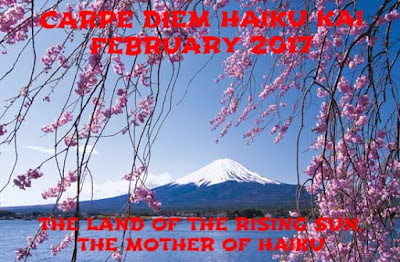Dear Haijin, visitors and travelers,
First this during lack of time I will not publish a new episode of Universal Jane this week, I hope to release a new episode next week. Because of this everlasting problem of time I have decided to create Universal Jane once in two weeks and I have a little change for the weekends. In the weekends I will publish only one episode of Carpe Diem Haiku Kai from now on. In other words I will have six (6) regular prompts a week instead of seven (7). I hope you are okay with that.
Today I love to tell you a little bit more about Sumi-e, the Japanese Way of Painting.
Ink wash
painting, also known as literati painting is an East Asian type of brush
painting of Chinese origin that uses black ink—the same as used in East Asian
calligraphy, in various concentrations. Names used in the cultures concerned include:
in Chinese shuǐ mò huà, in Japanese sumi-e or suibokuga , in Korean sumukhwa
, and in Vietnamese tranh thủy mặc .
Textual
evidence suggests that Shan shui style painting existed during China's Liu Song
dynasty of the fifth century. Ink wash painting developed further during the
Tang dynasty (618–907). The 8th-century poet/painter Wang Wei is generally
credited as the painter who applied color to existing ink wash paintings. The
art was further developed into a more polished style during the Song Dynasty
(960–1279).
Asian aesthetic writing is generally consistent in stating the goal of ink and wash painting is not simply to reproduce the appearance of the subject, but to capture its spirit. To paint a horse, the ink wash painting artist must understand its temperament better than its muscles and bones. To paint a flower, there is no need to perfectly match its petals and colors, but it is essential to convey its liveliness and fragrance. East Asian ink wash painting may be regarded as a form of expressionistic art that captures the unseen.
Asian aesthetic writing is generally consistent in stating the goal of ink and wash painting is not simply to reproduce the appearance of the subject, but to capture its spirit. To paint a horse, the ink wash painting artist must understand its temperament better than its muscles and bones. To paint a flower, there is no need to perfectly match its petals and colors, but it is essential to convey its liveliness and fragrance. East Asian ink wash painting may be regarded as a form of expressionistic art that captures the unseen.
 |
| Pine Trees (Sumi-e painting) |
In
landscape painting the scenes depicted are typically imaginary, or very loose
adaptations of actual views. Mountain landscapes are by far the most common,
often evoking particular areas traditionally famous for their beauty, from
which the artist may have been very distant. Water is very often included.
"The
painter ... put upon the paper the fewest possible lines and tones; just enough
to cause form, texture and effect to be felt. Every brush-touch must be
full-charged with meaning, and useless detail eliminated. Put together all the
good points in such a method, and you have the qualities of the highest
art".
Arthur Wesley Dow (1857–1922)
As I read the above again than I realize that sumi-e and haiku are almost similar with each other. Why? Well both art forms are representing an impression from a scene. Sumi-e through the paintwash and haiku through the pencil of the poet. Both art forms make use of the moment as short as the sound of a pebble thrown into water. Maybe we can say "sumi-e is haiku in paint" and "haiku is sumi-e in words".
I have tried to paint with words ...:
one summer
day
poppies coloring the meadows -
raindrops start to fall
poppies coloring the meadows -
raindrops start to fall
©
Chèvrefeuille
This episode is open for your submissions tonight at 7.00 PM (CET) and will remain open until February 20th at noon (CET).
Share your haiku, tanka or other Japanese poetry form inspired on this episode with us all here at our Haiku Kai.
| 1. | Virginia Popescu (2) | 5. | Kim M. Russell | 9. | Dolores | |
| 2. | Elsie Hagley | 6. | Xenia Tran | 10. | Ese | |
| 3. | B i r g i t t a | 7. | Nicole Pottier | 11. | shokunin | |
| 4. | petra domina | 8. | Sky | 12. | Sara McNulty |
(Cannot add links: Registration/trial expired)

Lovely haiku, Kristjaan.
ReplyDelete